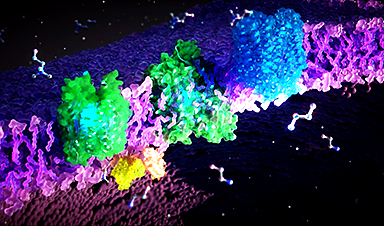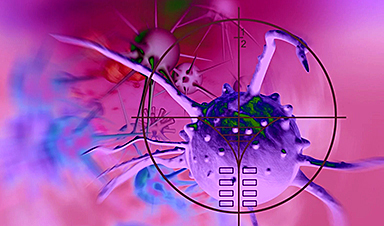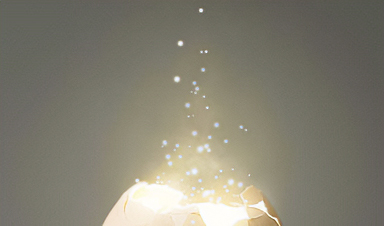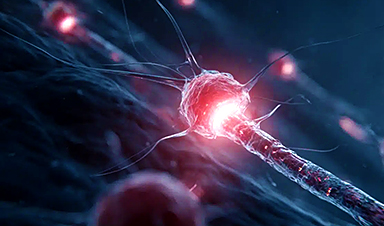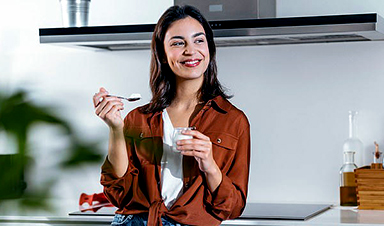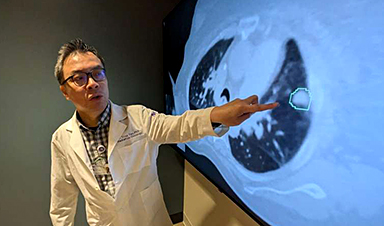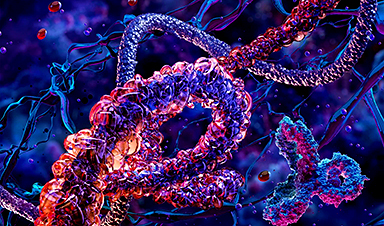The dynamic structure of FLVCR proteins and their role in nutrient transport within our cells have been revealed.
It is known that malfunctions of the proteins FLVCR1 and FLVCR2 lead to rare hereditary diseases in humans that cause motor, sensory and neurological disorders. However, the biochemical mechanisms behind this and the physiological functions of the FLVCR proteins have been unclear to date.
An interdisciplinary team of researchers from Frankfurt am Main, Singapore and the USA has now deciphered the FLVCR proteins’ 3D structures and their cellular functions. The researchers have shown that the proteins transport the cellular building blocks choline and ethanolamine. Their findings contribute significantly to understanding the pathogenesis of rare diseases and developing new therapies.
In hospital TV series such as Scrubs or Dr. House, medical doctors search for correct diagnoses and possible treatments for patients with sometimes puzzling or strange symptoms. In reality, this process often takes years for those affected by rare diseases. In many cases, there is no effective medication and therapeutic options are limited.
Approximately 6-8% of the world’s population suffers from a rare disease. That’s around 500 million people, even though each of the over 7000 different diseases only affects around one in 2000 people. Since these diseases are so rare, medical and scientific knowledge about them is limited. There are only a few experts worldwide and social awareness is lacking.
Unraveling the structure and function of proteins to understand diseases and develop therapies
An international team of researchers led by Schara Safarian, project group leader at the Max Planck Institute of Biophysics as well as independent group leader at the Fraunhofer Institute for Translational Medicine and Pharmacology ITMP, and the Institute of Clinical Pharmacology at Goethe University Frankfurt, has now investigated the structure and cellular function of two proteins, FLVCR1 and FLVCR2, which play a causal role in a number of rare hereditary diseases. The scientists have published their findings in the prestigious journal Nature.
Malfunctions of FLVCR1 and FLVCR2 due to gene mutations cause rare diseases, some of which result in severe visual, mobility, and sensory disorders – such as posterior column ataxia with retinitis pigmentosa, Fowler’s syndrome or sensory and autonomic neuropathies. The latter can, for example, lead to a complete loss of pain sensation. “In many diseases, including the rare ones, cellular structures in our body are altered and this leads to malfunctions in biochemical processes,” says Schara Safarian. “In order to understand the development of such diseases and develop therapies, we need to know how these proteins are structured at the molecular level and what functions they perform in healthy cells.”
FLVCR1 and FLVCR2 transport the cellular building blocks choline and ethanolamine
The scientists have discovered that FLVCR 1 and FLVCR2 transport the molecules choline and ethanolamine across the membranes of our cells. “Choline and ethanolamine are essential for important bodily functions. They support the growth, regeneration, and stability of our cells, for example in muscles, internal organs, and the brain,” explains Safarian. “Furthermore, choline is involved in fat metabolism and detoxification by the liver. Our body also needs it to produce the neurotransmitter acetylcholine which is crucial for our nervous system and is needed by our brain to control the organs. So, you can imagine that malfunctions of the FLVCR proteins can cause severe neurological and muscular disorders.”
The researchers used microscopic, biochemical, and computer-assisted methods to investigate the FLVCR proteins. “We shock-froze the proteins and then observed them under an electron microscope,” explains Di Wu, a researcher at the Max Planck Institute of Biophysics and co-author of the study. “An electron beam penetrates the frozen sample and the interaction of the electrons with the material creates an image.” The researchers take many individual images and process them and combine them computationally to obtain high-resolution 3D structures of proteins. In this way, they were able to decipher the structures of FLVCR1 and FLVCR2 and see how they change in the presence of ethanolamine and choline. Computer simulations confirmed and visualized how the FLVCR proteins interact with ethanolamine and choline, and dynamically change their structure to enable nutrient transport.
Safarian summarizes: “Our findings pave the way for understanding the development and progression of rare diseases associated with the FLVCR proteins. In the future, patients may be able to benefit from new therapies that restore their life quality.”
Reference: “Molecular mechanism of choline and ethanolamine transport in humans” by Keiken Ri, Tsai-Hsuan Weng, Ainara Claveras Cabezudo, Wiebke Jösting, Yu Zhang, Andre Bazzone, Nancy C. P. Leong, Sonja Welsch, Raymond T. Doty, Gonca Gursu, Tiffany Jia Ying Lim, Sarah Luise Schmidt, Janis L. Abkowitz, Gerhard Hummer, Di Wu, Long N. Nguyen and Schara Safarian, 22 May 2024, Nature.
DOI: 10.1038/s41586-024-07444-7
News
Most Plastic in the Ocean Is Invisible—And Deadly
Nanoplastics—particles smaller than a human hair—can pass through cell walls and enter the food web. New research suggest 27 million metric tons of nanoplastics are spread across just the top layer of the North [...]
Repurposed drugs could calm the immune system’s response to nanomedicine
An international study led by researchers at the University of Colorado Anschutz Medical Campus has identified a promising strategy to enhance the safety of nanomedicines, advanced therapies often used in cancer and vaccine treatments, [...]
Nano-Enhanced Hydrogel Strategies for Cartilage Repair
A recent article in Engineering describes the development of a protein-based nanocomposite hydrogel designed to deliver two therapeutic agents—dexamethasone (Dex) and kartogenin (KGN)—to support cartilage repair. The hydrogel is engineered to modulate immune responses and promote [...]
New Cancer Drug Blocks Tumors Without Debilitating Side Effects
A new drug targets RAS-PI3Kα pathways without harmful side effects. It was developed using high-performance computing and AI. A new cancer drug candidate, developed through a collaboration between Lawrence Livermore National Laboratory (LLNL), BridgeBio Oncology [...]
Scientists Are Pretty Close to Replicating the First Thing That Ever Lived
For 400 million years, a leading hypothesis claims, Earth was an “RNA World,” meaning that life must’ve first replicated from RNA before the arrival of proteins and DNA. Unfortunately, scientists have failed to find [...]
Why ‘Peniaphobia’ Is Exploding Among Young People (And Why We Should Be Concerned)
An insidious illness is taking hold among a growing proportion of young people. Little known to the general public, peniaphobia—the fear of becoming poor—is gaining ground among teens and young adults. Discover the causes [...]
Team finds flawed data in recent study relevant to coronavirus antiviral development
The COVID pandemic illustrated how urgently we need antiviral medications capable of treating coronavirus infections. To aid this effort, researchers quickly homed in on part of SARS-CoV-2's molecular structure known as the NiRAN domain—an [...]
Drug-Coated Neural Implants Reduce Immune Rejection
Summary: A new study shows that coating neural prosthetic implants with the anti-inflammatory drug dexamethasone helps reduce the body’s immune response and scar tissue formation. This strategy enhances the long-term performance and stability of electrodes [...]
Scientists discover cancer-fighting bacteria that ‘soak up’ forever chemicals in the body
A family of healthy bacteria may help 'soak up' toxic forever chemicals in the body, warding off their cancerous effects. Forever chemicals, also known as PFAS (per- and polyfluoroalkyl substances), are toxic chemicals that [...]
Johns Hopkins Researchers Uncover a New Way To Kill Cancer Cells
A new study reveals that blocking ribosomal RNA production rewires cancer cell behavior and could help treat genetically unstable tumors. Researchers at the Johns Hopkins Kimmel Cancer Center and the Department of Radiation Oncology and Molecular [...]
AI matches doctors in mapping lung tumors for radiation therapy
In radiation therapy, precision can save lives. Oncologists must carefully map the size and location of a tumor before delivering high-dose radiation to destroy cancer cells while sparing healthy tissue. But this process, called [...]
Scientists Finally “See” Key Protein That Controls Inflammation
Researchers used advanced microscopy to uncover important protein structures. For the first time, two important protein structures in the human body are being visualized, thanks in part to cutting-edge technology at the University of [...]
AI tool detects 9 types of dementia from a single brain scan
Mayo Clinic researchers have developed a new artificial intelligence (AI) tool that helps clinicians identify brain activity patterns linked to nine types of dementia, including Alzheimer's disease, using a single, widely available scan—a transformative [...]
Is plastic packaging putting more than just food on your plate?
New research reveals that common food packaging and utensils can shed microscopic plastics into our food, prompting urgent calls for stricter testing and updated regulations to protect public health. Beyond microplastics: The analysis intentionally [...]
Aging Spreads Through the Bloodstream
Summary: New research reveals that aging isn’t just a local cellular process—it can spread throughout the body via the bloodstream. A redox-sensitive protein called ReHMGB1, secreted by senescent cells, was found to trigger aging features [...]
AI and nanomedicine find rare biomarkers for prostrate cancer and atherosclerosis
Imagine a stadium packed with 75,000 fans, all wearing green and white jerseys—except one person in a solid green shirt. Finding that person would be tough. That's how hard it is for scientists to [...]
